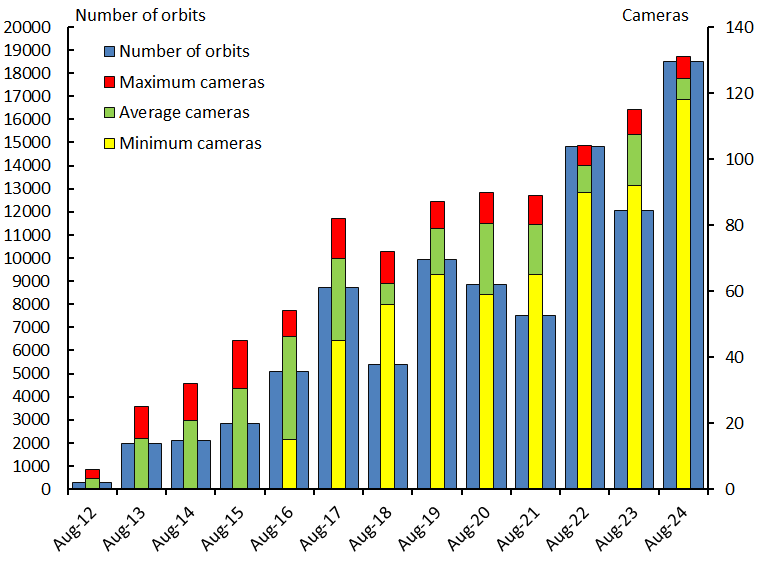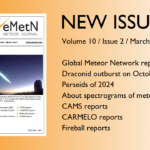Abstract: A summary of the activity of the CAMS-BeNeLux network during the month of August 2023 is presented. This month was good for 43080 multi-station meteors resulting in 12074 orbits.
Introduction
In August, of course, all attention goes to the Perseid meteor shower, peaking around August 12. Little moonlight this year in the first half of the month offered favorable conditions. It was going to be a very successful month.
August 2024 statistics
The month of August was by far the sunniest and warmest summer month in 2024. Since the start of CAMS in 2012, it has only been sunnier in August in 2022. But even the less sunny days were often followed by a (partially) clear night this month. There was not a single night this month without simultaneous meteors. This has happened before since the start of this project in the BeNeLux, but never before have the lowest scores in one night been so high during an entire month. Only in two nights did we collect less than 100 orbits: 80 orbits in the night of August 3–4 and 31 orbits in the night of August 17–18. More than 1000 orbits were collected in 5 nights (August 5–6 and in all nights from August 9–12). The nights around the Perseid maximum were the highlights when 2761 (August 11–12) and 2882 orbits (August 12–13) were collected under clear sky conditions.
All cameras in CAMS-BeNeLux captured a total of 133634 meteors this month. Of these, 69684 were simultaneous. In the end, this resulted in a total of no less than 18522 orbits. This is by far the best result for August since 2012 (Figure 1 and Table 1). 59.7% of all orbits were collected from more than two stations.

Figure 1 – Comparing August 2024 to previous months of August in the CAMS-BeNeLux history. The blue bars represent the number of orbits, the red bars the maximum number of cameras capturing in a single night, the green bars the average number of cameras capturing per night and the yellow bars the minimum number of cameras.
Table 1 – Number of orbits and active cameras in CAMS-BeNeLux during the month of August in the period 2012–2024.
| Year | Nights | Orbits | Stations | Max. Cams | Min. Cams | Mean Cams |
| 2012 | 21 | 283 | 5 | 6 | – | 3.2 |
| 2013 | 27 | 1960 | 13 | 25 | – | 15.3 |
| 2014 | 28 | 2102 | 14 | 32 | – | 20.8 |
| 2015 | 25 | 2821 | 15 | 45 | – | 30.4 |
| 2016 | 30 | 5102 | 20 | 54 | 15 | 46.2 |
| 2017 | 28 | 8738 | 21 | 82 | 45 | 69.9 |
| 2018 | 30 | 5403 | 19 | 72 | 56 | 62.4 |
| 2019 | 29 | 9916 | 23 | 87 | 65 | 79.0 |
| 2020 | 31 | 8845 | 24 | 90 | 59 | 80.6 |
| 2021 | 29 | 7496 | 27 | 89 | 65 | 80.2 |
| 2022 | 31 | 14807 | 31 | 104 | 90 | 98.1 |
| 2023 | 31 | 12074 | 37 | 115 | 92 | 107.3 |
| 2024 | 31 | 18522 | 52 | 131 | 118 | 124.5 |
| Total | 371 | 98069 |
Part of this great result is also due to a significant expansion of our network with stations in the East of England. Seven RMS cameras in this country started to provide camera data to our project. Nick Russell (Seaford, UK), and Alan Maunder (Catherington, UK) started their contributions with 1 and 2 RMS cameras respectively on August 9. Nick James (Chelsford, UK) delivers his data to our network since August 11. Jamie Olver (Redhill, UK) since August 12. Steve Carter (Welwyn Garden City, UK) made his first contributions on August 16. Finally, contributions by Miles Eddowes (Reading, UK) are available since August 20. Together with data of the other UK cameras of Andy Washington and Jim Rowe, who are contributing already for several months, these stations have already contributed to a total of 1992 simultaneous meteors during the month of August. In the Netherlands, Rob Smeenk placed another RMS-camera in Assen on August 11. The number of captured meteors by this camera is already considerable: no less than 910 meteors of his total number of meteors this month were simultaneous.
The atmosphere over the southwest of the Netherlands is now better covered with cameras, since the station in Oostkapelle unfortunately stopped running, at least for some months, in June. The cameras of Steve Rau (Zillebeke, Belgium) have also been switched off since 23 August due to renovation work. Restart of these cameras will probably follow in November.
During the Perseid maximum, we were also treated to the activity of a new meteor shower. Peter Jenniskens called this new meteoroid stream the ‘nu Capricornids’ (Jenniskens, 2024a; 2024b). CAMS-BeNeLux collected no less than 19 meteor orbits of this new meteoroid stream. On average, 124 cameras were active every night this month. This high number is of course also a result of the expansion of our network this month. A minimum of 118 cameras and a maximum of 131 cameras were active each night
(Figure 1 and Table 1).
Conclusion
In August 2024 we have captured a record number of meteors, resulting in a new record of orbits for this month, thanks to excellent weather and a significant expansion of our network, especially in the United Kingdom.
Acknowledgement
Many thanks to all participants in the CAMS-BeNeLux network for their dedicated efforts. The CAMS-BeNeLux team was operated by the following volunteers during the month of August 2024:
Stéphane Barré (Colombey-Les-Belles, France, RMS 3907), Hans Betlem (Woold, Netherlands, Watec 3071, 3072, 3073, 3074, 3075, 3076, 3077 and 3078) , Felix Bettonvil (Utrecht, Netherlands, CAMS 377), Jean-Marie Biets (Engelmanshoven, Belgium, Watec 3180, 3181, 3182 and 3183), Ludger Boergerding (Holdorf, Germany, RMS 3801), Günther Boerjan (Assenede, Belgium, RMS 3823), Martin Breukers (Hengelo, Netherlands, Watec 320, 321, 322, 323, 324, 325, 326 and 327, RMS 319, 328 and 329 ), Jean Brunet (Fontenay le Marmion, France, RMS 3911), Seppe Canonaco (Genk, RMS 3818 and 3819), Steve Carter (Welwyn Garden City, England, RMS 3706), Pierre de Ponthiere (Lesve, Belgium, RMS 3816 and 3826), Bart Dessoy (Zoersel, Belgium, Watec 398, 805 and 806 and RMS 3827), Jürgen Dörr (Wiesbaden, Germany, RMS 3810, 3811 and 3812), Isabelle Ansseau, Jean-Paul Dumoulin, Dominique Guiot and Christian Wanlin (Grapfontaine, Belgium, Watec 814, 815, RMS 3817, 3843, 3844 and 3845), Miles Eddowes (Reading, England, RMS 3709), Uwe Glässner (Langenfeld, Germany, RMS 3800), Roel Gloudemans (Alphen aan de Rijn, Netherlands, RMS 3197), Luc Gobin (Mechelen, Belgium, Watec 3890, 3891, 3892, 3893 and 3894), Tioga Gulon (Nancy, France, Watec 3900 and 3901), Tioga Gulon (Chassignolles, France, RMS 3910), Robert Haas (Alphen aan de Rijn, Netherlands, Watec 3160, 3161, 3162, 3163, 3164, 3165, 3166 and 3167), Robert Haas (Burlage, Germany, RMS 3803 and 3804), Kees Habraken (Kattendijke, Netherlands, RMS 3780, 3781, 3782 and 3783), Erwin Harkink (Elst, Netherlands, RMS 3191), Nick James (Chelmsford, England, RMS 3710), Carl Johannink (Gronau, Germany, Watec 3100, 3101, 3102), Reinhard Kühn (Flatzby, Germany, RMS 3802), Hervé Lamy (Dourbes, Belgium, Watec 394 and 395, RMS 3825, 3841, 3895, 3896, 3897 and 3898), Hervé Lamy (Humain, Belgium, RMS 3821 and 3828), Hervé Lamy (Ukkel, Belgium, Watec 393 and 817), Hartmut Leiting (Solingen, Germany, RMS 3806), Arnoud Leroy (Gretz-Armainvielliers, France, RMS 3909), Alan Maunder (Catherington, England, RMS 3707-3708), Horst Meyerdierks (Osterholz-Scharmbeck, Germany, RMS 3807), Koen Miskotte (Ermelo, Netherlands, Watec 3051, 3052, 3053 and 3054), Jamie Olver (Redhill, England, RMS 3705), Pierre-Yves Péchart (Hagnicourt, France, RMS 3902, 3903, 3904, 3905, 3906 and 3908), Holger Pedersen (Otterup, Denmark, RMS 3501), Eduardo Fernandez del Peloso (Ludwigshafen, Germany, RMS 3805), Tim Polfliet (Gent, Belgium, Watec 396, RMS 3820 and 3840, Tim Polfliet (Grimbergen, Belgium, RMS 3846), Steve Rau (Oostende, Belgium, RMS 3822), Steve Rau (Zillebeke, Belgium, Watec 3850 and 3852, RMS 3851 and 3853), Paul and Adriana Roggemans (Mechelen, Belgium, RMS 3830, Watec 3832, 3833, 3834, 3835, 3836 and 3837), Jim Rowe (Eastbourne, England, RMS 3703), Nick Russell (Seaford, England, RMS 3704), Philippe Schaack (Roodt-sur-Syre, Luxemburg, RMS 3952), Romke Schievink (Bruchhausen Vilsen, Germany, RMS 3808 and 3809), Hans Schremmer (Niederkruechten, Germany, Watec 803), Rob Smeenk (Assen, Netherlands, RMS 3190 and 3196), Rob Smeenk (Kalenberg, Netherlands, RMS 3192, 3193, 3194 and 3195), Erwin van Ballegoij (Heesh, Netherlands Watec 3148 and 3149), Andy Washington (Clapton, England, RMS 3702).
References
Jenniskens P. (2024a). “Perseid-season meteor outburst with a radiant in Capricorn”. eMetN, 9, 286–287.
Jenniskens P. (2024b). “New meteor shower with a radiant in Capricornus”. CBET 5434; 2024 August 20, editor D. W. E. Green.



UK0004 has also been contributing data for about two years.
Yes indeed and this camera contributed to many paired meteors within CAMS-BeNeLux! 949 so far in 2024 alone until August. The author of the report introduces new participants, if any, in these monthly reports while all contributing camera operators are mentioned in the acknowledgment. Thanks for your support to CAMS-BeNeLux.